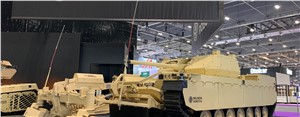Pearson Engineering and Milrem Robotics Collaboration Explores Mobility and Survivability for Robotic Combat Vehicles
September 13, 2021
-Collaboration between British company Pearson Engineering and the European leading robotics and autonomous systems developer Milrem Robotics will see the Type-X Robotic Combat Vehicle (RCV) showcased with a Self-Protection Roller at DSEI 2021. The integration of the two capabilities marks an effort to develop market thinking on the future roles of RCVs and the support they may need, or give to other vehicles, on the battlefield.
RCVs look set to take a prominent position in the configuration of military land forces in future conflict, progressively taking humans away from ‘dumb, dangerous and dirty’ tasks and affording skilled personnel the time and safety to outwit adversaries.
Engineering Director at Pearson Engineering, Jason Riby said “How RCVs will be deployed is still a matter of discussion with a trend towards lighter, nimbler, and more multi-purpose vehicles able to undertake a multitude of roles independently”.
“The fact remains, that these vehicles will need to move to places of their Commander’s choosing and in doing so, will need to defeat the wide range of natural and deliberate obstacles usually encountered on the battlefield. An RCV without protection may still be subject to enemy action, if not to injure soldiers, but to stop valuable assets in their tracks”.
“The Type-X is designed to be a wingman for manned IFV’s and MBT’s and it can have many different roles on the battlefield. Combining it with excellent protection and route proving technologies from Pearson Engineering will significantly increase the survivability of not only the Type-X, but also of manned units,” said Kuldar Väärsi, CEO of Milrem Robotics.” The future battlefield is about manned-unmanned teaming, and the task of the industry is to provide clever solutions for capability building,” Väärsi added.
The Type-X RCV is equipped with intelligent functions such as follow-me, waypoint navigation and obstacle detection with Artificial Intelligence part of the algorithms.
The vehicle’s maximum speed is 80 km/h on paved roads and 50 km/h off-road. The low weight of 12 tons of the Type-X and high power with efficient power management provide a superior terrain capability.
The integration of the Light Weight Mine Roller (a type of roller designed for self-protection) to the Type X at DSEI gives just one example of the range of possibilities available for the future of unmanned vehicles on the battlefield. Equipment to support minefield breaching, route clearance, obstacle reduction, recovery and gap crossing could also be integrated, and some of this has already been proved possible during trials in the United States with the Remote Control Assault Breacher Vehicle (R-ABV).
The Light Weight Mine Roller will be integrated via a Pearson Engineering Vehicle Integration Kit. This will allow Type-X to easily accept a number of different types of front end equipment, including dozer blades, equipment for the clearance of surface laid mines and for assault gap crossing.
Pearson Engineering and Milrem Robotics are also exploring options for the THeMIS Unmanned Ground Vehicle (UGV). The multi-role UGV has been operationally proven on exercise and has already been acquired by 11 countries, including 7 NATO members.
Source : Milrem

Related Studies

Main Battle Tanks - Market and Technology Forecast to 2032
Publish date: December 2024 - Pages: 131

Military Unmanned Ground Vehicles (UGV) - Market and Technology Forecast to 2030
Publish date: December 2022 - Pages: 195

Military Robots and Autonomous Systems - Market and Technology Forecast to 2030
Publish date: December 2022 - Pages: 211